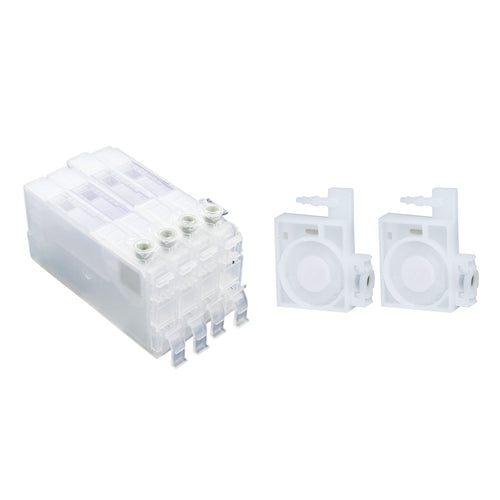1. Introduction
Of the rapidly emerging printing technology business nowadays, it is definite that Laser Printing and Inkjet Printing are the most widely employed base technologies. Because of its effectiveness and precision, laser printing has been appropriate for office and industrial-level printing applications, whereas the inkjet method is praised for its color depiction and flexibility, especially on image and personalized product printings.
Among the inkjet printing revolutions, Direct-to-Film (DTF) Printing is one of the leading technologies of recent years, particularly in the apparel and personalized products businesses, which has been found to have an enormous potential. Here, we shall draw a thorough comparison between the concepts, materials, operation complexity, and circumstances under which Laser Printing and DTF Printing may be utilized to enlighten you on how they differ and what advantages each has to allow you to make a better-informed decision.

2. What is Laser Printing
2.1 Definition of Laser Printing
Laser printing is a technique of printing using a laser beam and electrostatic imaging technology to put toner (a powder) onto paper or media. Laser printing is widely used in offices, business, and industry due to its high print speed, quality print of text, and excellent durability.
2.2 Working Principle of Laser Printing
Electrostatic imaging and thermal transfer is the underlying technology for laser printing. The following are the common steps involved:

- Data Processing:
The other computer or devices send the print data to the laser printer, which is then converted by the printer controller into a format suitable for laser scanning.
- Charging the Photoreceptor Drum:
The photoreceptor drum, a cylindrical object coated with photoconductive material, is uniformly charged with negative or positive charges (depending on the specific printer) before printing begins.
- Laser Exposure:
The laser selectively exposes the photoreceptor drum based on the print data, discharging areas to create a latent electrostatic image. The areas not exposed to the laser retain their original charge.
- Developing:
A toner unit filled with toner particles of the opposite charge attaches the toner to the exposed areas, revealing the image or text.
- Transfer:
The paper is fed into the print area, carrying a charge opposite to that of the toner on the drum. The toner image on the drum is transferred onto the paper.
- Fusing:
The paper is subsequently passed between a high-temperature (usually 180-200°C) and high-pressure fusing roller that melts the toner so that it attaches to the paper fibers in a permanent fashion, resulting in a permanent print.
- Cleaning and Recharging:
After printing, the photoreceptor drum is cleaned by a mechanism that removes any excess toner and recharged in preparation for the next print.
3. What is DTF Printing
3.1 What is DTF Printing?
DTF (Direct-to-Film) Printing is a new digital printing technology that uses special water-based pigment inks to print images on PET (Polyester) film, and transfers the design to fabric or other materials through heat transfer. It overcomes the limitations of traditional sublimation and screen printing, and can offer high-quality prints on various fabric colors and materials, particularly cotton, polyester, and blends..
3.2 Working Principle of DTF Printing
The DTF printing process involves the following steps:

4. Similarities Between DTF Printing and Laser Printing
Direct-to-film (DTF) printing and laser printing both share the following similarities in printing color images and designs:
CMYK Color Model: Both are CMYK color models that combine cyan, magenta, yellow, and black in order to produce colourful and clear images and designs.
Preprocessing Image: Both DTF printing and laser printing utilize preprocessing in order to sufficiently replicate colour and concentration in the print output.
Color Precision: Both the technologies employ precise color management and calibration for ensuring that the printed output is extremely close to the design, particularly for complex patterns and gradient effects.
Next, we will talk about the main differences between both.
5. Laser Printing vs DTF Printing: Key Differences
5.1 Material Compatibility


Laser Printing: Laser printing is best suited to paper, labels, cards, and plastic media. These are easily printed with a laser printer, and it is mostly used for vast quantities of text and low-level graphics.
DTF Printing: DTF printing also boasts an extremely broad application range and is capable of high-quality images on various kinds of fabric (such as cotton, polyester, etc.) and other materials such as plastic, leather, and wood. This also renders the DTF method ideal for custom apparel, personalized products, and promotional items.
5.2 Print Quality and Effects


Laser Printing: Laser printing is better in printing text and fine details with clear, sharp text and plain graphics. It works well with black-and-white images and hence ideal for business documents, reports, and office work. It does not work well with color images and complex gradient designs.
- DTF Printing: DTF printing excels in color reproduction, gradient effects, and detail presentation. It is capable of producing bright colors and rich layers, and therefore is perfect for intricate designs and multi-color prints. Due to its wide material compatibility, it can produce high-quality prints on different surfaces, making it a perfect top choice for custom products and printing on clothing.
5.3 Cost Comparison


Laser Printing: Laser printers are less expensive to purchase initially and last longer. Toner expense is minimal, and cost per page to print is also very inexpensive. As a whole, laser printing is cost-effective in the long term, especially for high-volume document printing.
- DTF Printing: DTF printing requires a higher initial capital investment in specialized inkjet printers, heat transfer machines, and supplies such as PET film and hot-melt adhesive powder. While it yields higher print quality, DTF printing has higher operational costs compared to laser printing.
5.4 Ease of Use and Operational Complexity
Laser Printing: Laser printers are simple to use. Most laser printers are plug-and-play, with straightforward operation suitable for office and home environments. Users simply need to change toner cartridges or drums occasionally and keep printers clean.
DTF Printing: DTF printing is slightly more advanced and entails the utilization of additional equipment such as a heat transfer machine and hot-melt adhesive powder. Adjusting the DPI, heat transfer, and other technical aspects are also involved in the process, so operators will require more trainings.
However, there are leading DTF printer companies that offer professional tutorials for beginners. Like InkSonic Online Academy .
5.5 Applicable Scenarios
Laser Printing
- Laser printing is most suitable for everyday office use, particularly in scenarios where large amounts of text and document printing are required, such as business documents, reports, files, business cards, and labels.
- However, this is also its limitation, as it can only print on specific types of paper and cannot transfer prints onto other materials, thus unable to meet the customization needs for products made from different materials.
DTF Printing

- DTF printing is the revolutionary technology for personalized products, especially in fields like custom garment printing, custom promotional products, and custom printing businesses on various materials.
- From T-shirts, hats, brochures to tote bags, and from small to bulk orders, DTF printing offers vibrant and durable prints, thus the widespread use of DTF in the custom market.
- Also, according to the recent figures, custom gift business will probably experience gigantic growth in 2025, with increased opportunities. If you want to take this profitable chance soon, go through the blog on how to start a custom business quickly using DTF printers.
6. Conclusion: How to Choose?
If you intend to join the custom product business and aim to create business value with printing technology, DTF printing is the better option. While the startup cost is greater, its versatility, better color performance, and wide material compatibility enable wider business opportunities and greater long-term profitability.
But if your main requirement is printing office documents on a daily basis, laser printing is definitely the more economical and efficient option, providing solid support for business purposes.

































